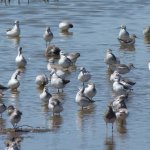By Ana Agreda, Aves y Conservación and Fernando Angulo, CORBIDI
2022 has been a special year. After more than 15 years of work focused on the conservation of migratory shorebirds, we were finally able to experience Alaska, the place where many of our shorebirds will nest, spending a few months away from us. As part of a regional working group, collaborating on migratory shorebird conservation, traveling to Alaska has been a life goal. While we work so hard to conserve their wintering sites, we always have this desire to know the other wetlands they visit across the hemisphere.
This dream was to be fulfilled in May 2020, but was postponed indefinitely when our lives suddenly changed with the Covid-19 pandemic. After two years, in April 2022 we finally received a message from Jim Chu, Wildlife Specialist of the United States Forest Service (USFS) informing us that we should pack our bags because we would be able to visit two of the most important and extensive protected areas in Alaska: Tongass and Chugach National Forest Park, and the Copper River Delta, which hosts 90% of the biogeographic populations of the Pacific Dunlin (Calidris alpina pacifica) and Western Sandpiper (C. mauri), for which it was designated as a WHSRN Site of Hemispheric Importance in 1990.
We started our trip with many expectations, each one to be fulfilled. We knew that we would find completely new landscapes, but we were not prepared for them to be so impressive and much less that we would be able to visit glaciers. First in Wrangell, we were warmly welcomed by the USFS district staff, then in Anchorage we visited with Audubon Alaska and the Westchester Lagoon and finally in Cordova again the USFS provided us with visits to several incredible wetlands where migratory shorebird studies are conducted. At each of these sites, the warmth with which we were received, the magnificent scenery, and the shorebirds surpassed anything we could have imagined before we arrived.
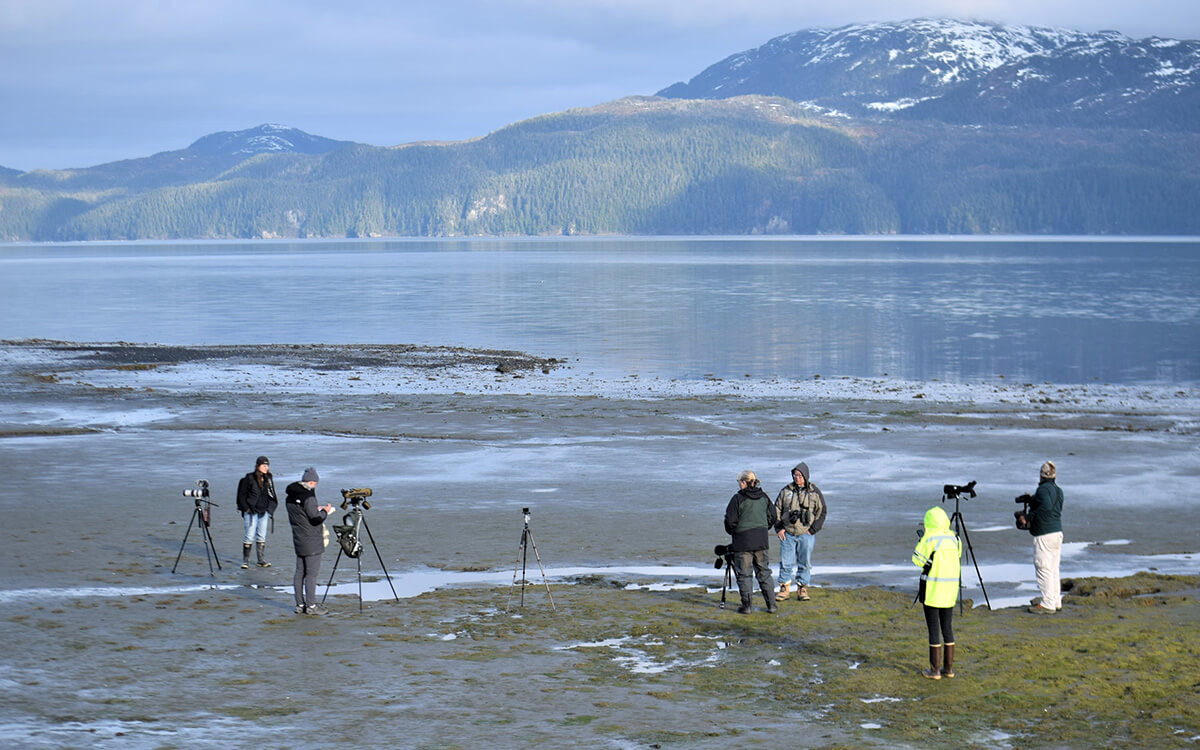

Left: Biologist observe shorebirds from the shore of a mudflat. Right: Harbor Seals lounging on the ice. Photos: Ana Agreda.
The scenery was exceptional. I remember that no matter how hard I tried to take the perfect picture, my camera could not reproduce the image my eyes were capturing, so I decided to simply enjoy and marvel at the view in silence. Spectacular sites such as the shimmering, icy glaciers of the Stikine River, Sheridan and the Copper River Delta itself, were among the most amazing experiences we had. As Fernando stated, “Alaska’s scenery is breathtakingly beautiful, in part due to the amount of snow in the mountains and the geography of the fjords, the brilliant blue of the sky and the contrast with the immaculate white of the snow.”
Although we went as shorebird experts, it is impossible not to marvel at all the wildlife present. Fernando was persistent about having a list of mammals so we always kept an eye out for moose, black bears, mountain goats, seals, otters, sea lions, and of course humpback whales and orcas. It was also a spectacle in terms of the birdlife present, among the new bird species on our list we added the White-winged Scoter (Melanitta deglandi) and Surf Scoter (M. perspicillata) that we saw in large numbers from the first moment. We also added the beautiful Common Goldeneye (Bucephala clangula) and Harlequin Ducks (Histrionicus histrionicus) that were affected by the Exxon Valdez oil spill in 1989. Little by little their numbers are beginning to increase. We also saw several species of gulls among the most outstanding the Bonaparte’s Gull (Chroicocephalus philadelphia) and Black-legged Kittiwake (Rissa tridactyla).
But what took our breath away was the sight of flocks of migratory shorebirds in their breeding plumages, especially some species very difficult to spot in South America such as the Dunlin, the Red Knot (C. canutus roselaari) and the beautiful Marbled Godwit (Limosa fedoa) and Hudsonian Godwits (L. haemastica). Once we visited Hartney Bay, our observations increased significantly. We returned to this site several times, as this beach hosts thousands of Western Sandpipers, we also observed Semipalmated Sandpipers (Charadrius semipalmatus), Least Sandpipers (C. minutilla), Dunlin (C. alpina pacifica), Black-bellied Plover (Pluvialis squatarola) and American Golden Plover (P. dominica).
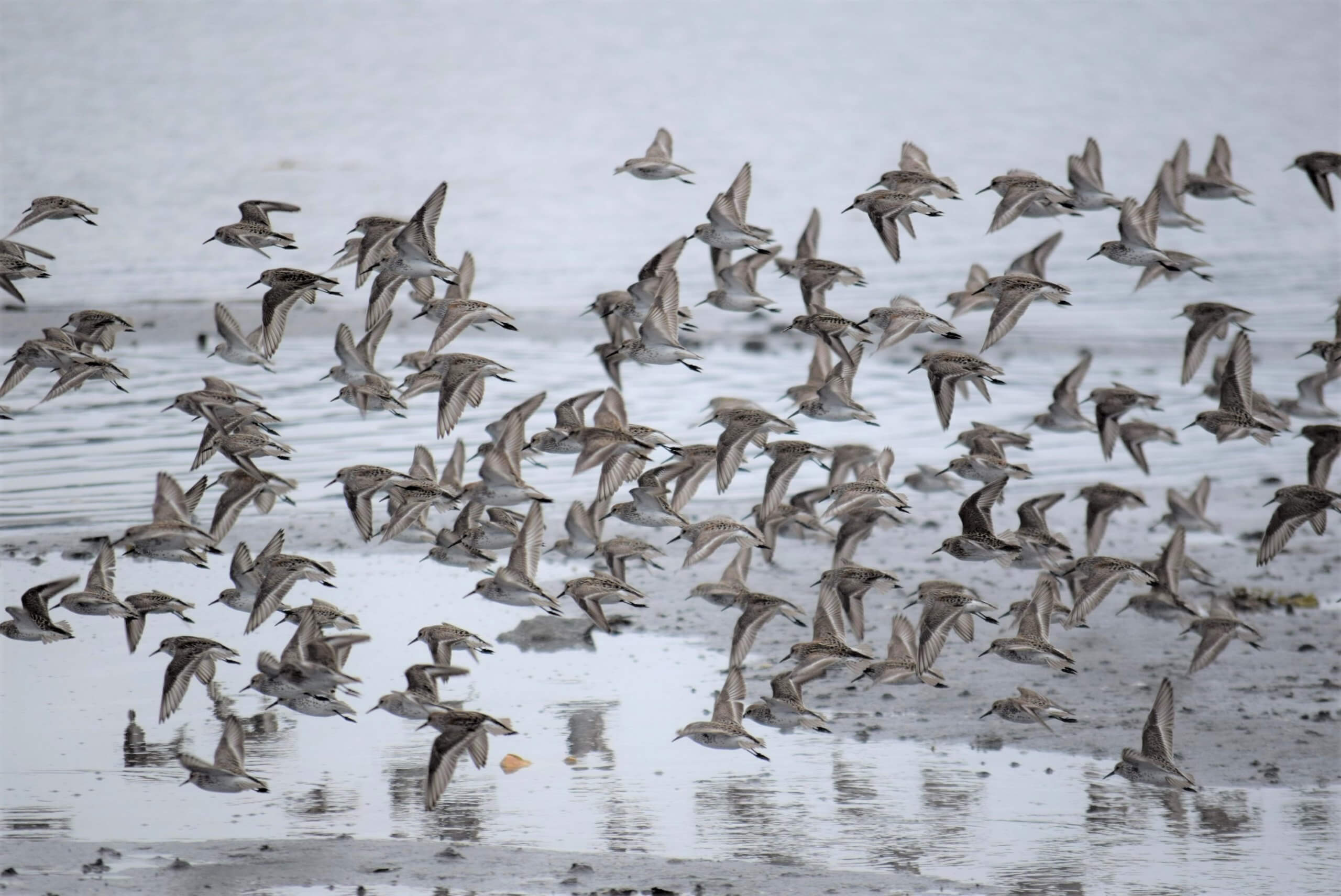
Flock of Western Sandpipers at Hartney Bay in Cordova, Alaska. Photo: Ana Agreda
During our visit we had the opportunity to participate in the Copper River Delta Shorebird Festival. This experience allowed us to see in action how art is one of the most effective tools for educating and increasing awareness about shorebirds. Exquisite photographs, paintings, shorebird crafts, and beautiful handicrafts were displayed in the halls of the Cordova Museum and Historical Center during the three-day event.
For Fernando, one of the lessons learned from participating in the festival was to understand how the festival’s target audience in Cordova differs from local experiences in Peru. For the Copper River Delta Shorebird Festival, the target audience is birders and bird enthusiasts from the surrounding area, Alaska, and elsewhere in the United States. The local public in Cordova, is quite steeped and involved in the festival. The festival atmosphere is “breathed” throughout the town, and it is enhanced by the arrival of interested outside visitors. The festivals organized by CORBIDI in Peru, for example, in Ciudad Eten and San José (Lambayeque, north coast), are used to educate the local population about shorebirds, their habitats, threats, and how to learn to coexist with them. Festivals in Ecuador also focus on a local audience that includes managers and communities linked to wetlands. In Ecuador, the festivals occur at multiple sites and include a series of different experiences at each site, the co-hosting organizations at each site, for example, Salinas, Bahía de Caráquez, Balao and Naranjal, are government organizations which attracts more interest from the local community.
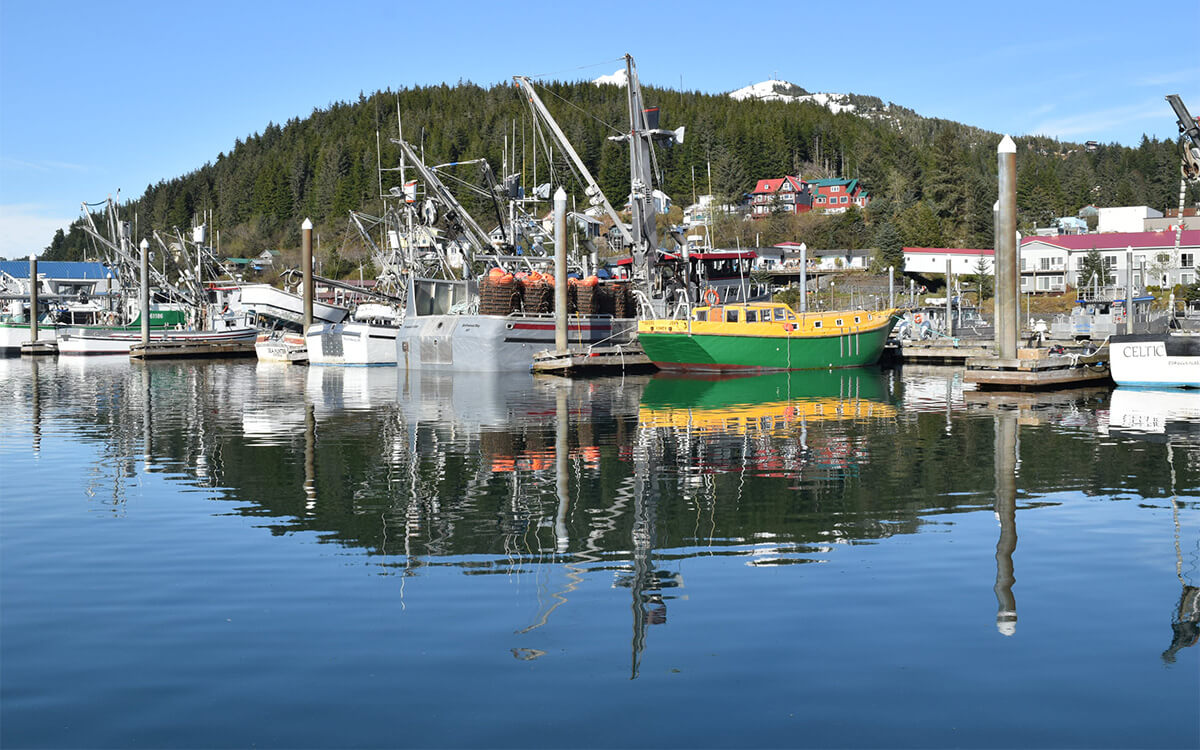
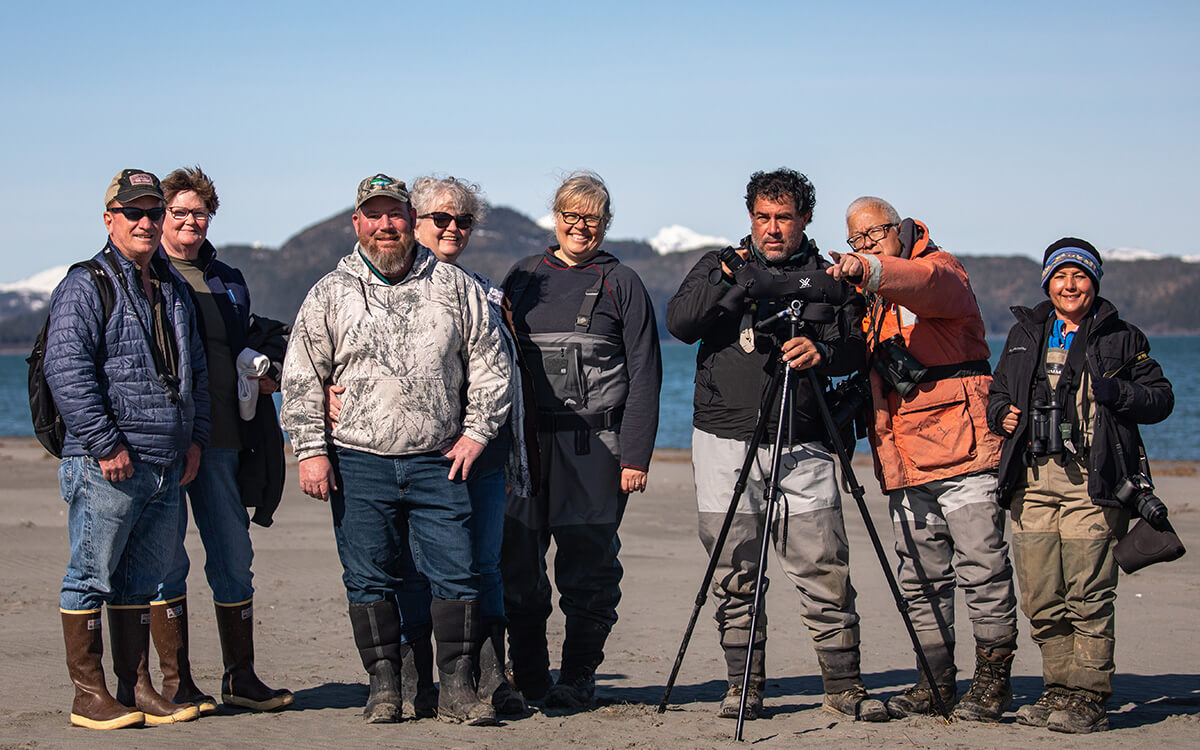
Left: Fishing boats in the scenic Cordova, Alaska. Right: Ana Agreda, Fernando Angulo, Jim Chu, and other local partners and biologists in Alaska. Photos: Ana Agreda.
This was undoubtedly an unprecedented trip, an unexpected one and at the same time one of the most longed-for experiences. The experiences will remain not only in our memory, but will enrich our work in shorebird conservation at our sites in South America, by linking new stakeholders, new ways of taking action, and new monitoring techniques. We will soon be setting up Motus satellite tracking stations in our countries which will link directly with the work in Alaska.
We would like to extend a thank you to everyone who made our visit possible, especially Jim Chu, Erin Cooper, Wrangell District Chief Clint Kolarich, Joe Delabroue, Erick LaPrice, Nick Docken (USFS Motus manager), Sean Made, Cordova District Chief Steve Namitz, Chungach National Forest Chief Jeff Schramm, Thea Thomas, and River Gates and David Krause of the Alaska Audubon Society.
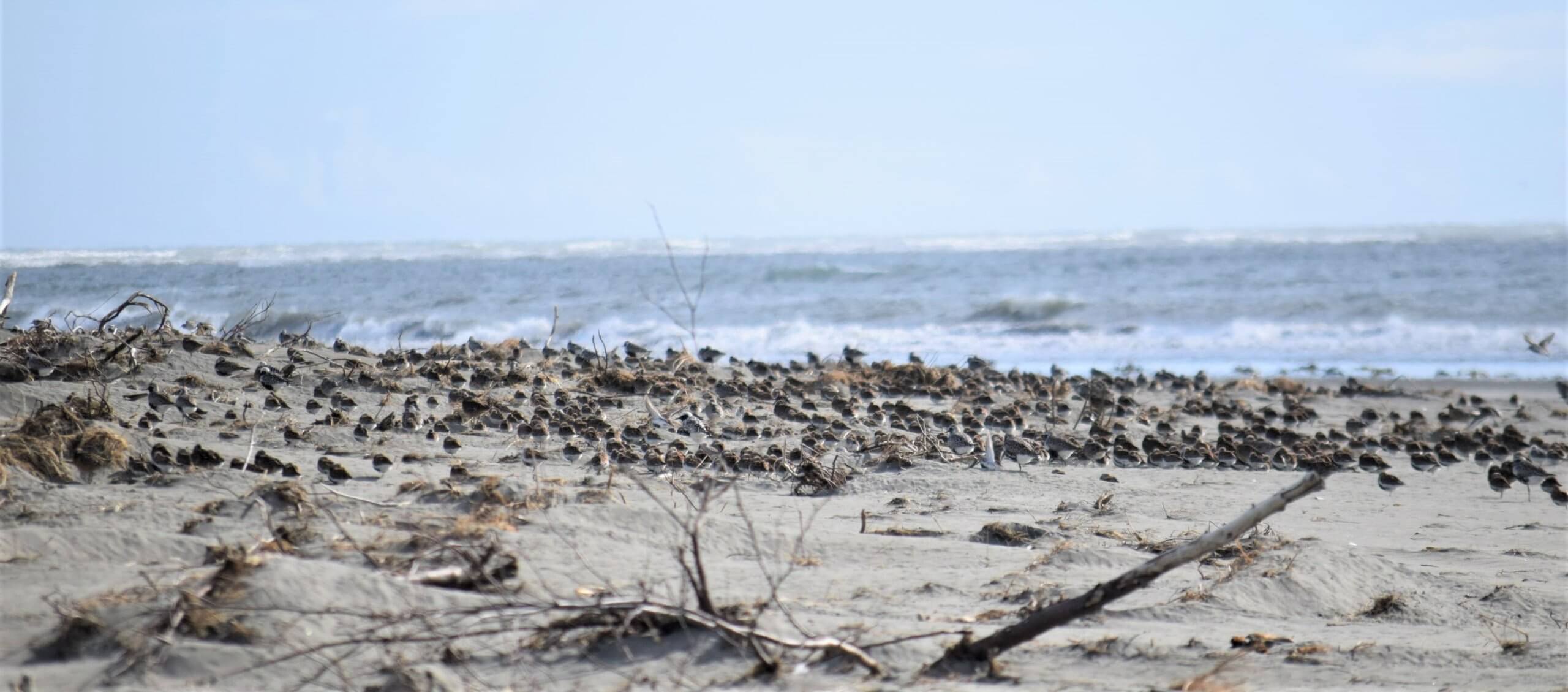
Flock of Dunlins roosting on a beach at Little Egg Island. Photo: Ana Agreda
Cover Photo: Flock of shorebirds, Hartney Bay, Cordova, Alaska. Photo: Ana Agreda.





